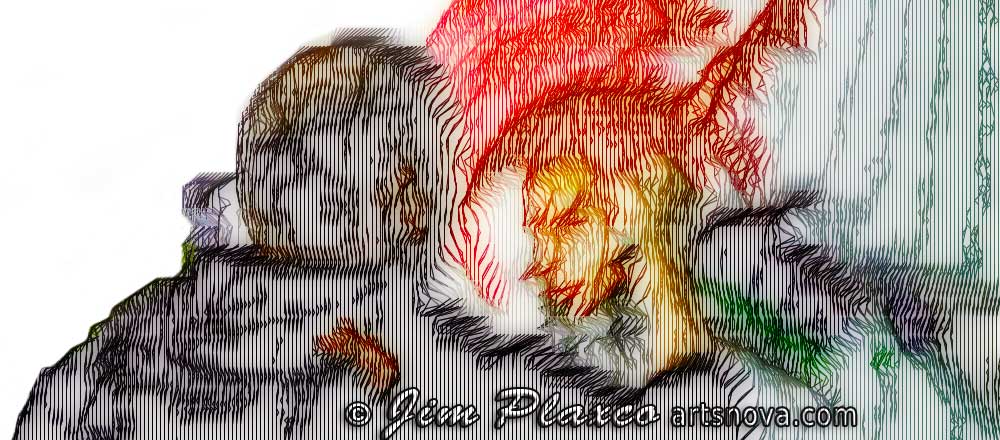The Artist's Digital Art Tools

Digital Art Tools Creative Coding Example
One of the most exciting aspects of the digital art creation process is the wide variety of tools at the artist's disposal. When you couple the variety of tools with the fact that any mixture of these tools can be used collectively to create art, the result is that the digital artist is far more liberated and free to explore than his traditional art counterparts.
Computer Graphics Software Used in the Digital Art Creation Process
The graphic software that I use can be separated into three broad categories. As a creative coder, the first category of software would be the programs that I create. These consist of a variety of image processing, algorithmic, and generative art programs. The second category would be the traditional commercial 2D paint and image processing software packages. The third category would be what is known as integrated 3D software packages. In addition, there are various graphics utilities whose only purpose is to facilitate the opening and reading of various image files. For example, the FITS Liberator Photoshop Plugin is a package that makes it possible for Photoshop to open and read astronomical image files, such as those produced by the Hubble Space Telescope. NASAVIEW is a utility that allows the user to open and convert to a standard graphics file format the Planetary Data System IMG files used to store the images returned by the various planetary exploration missions.
Custom Computer Graphics Software
While I do use commercially available 2D and 3D software for the creation of my digital art, I rely heavily on graphics software of my own creation. This includes both digital painting software as well as image manipulation software. The two programming languages that I use are C++ and Java. When using Java, I rely on the Processing Programming Language framework. In addition, I have written some small Perl applications for use in conjunction with Adobe Photoshop. I'm also thinking about writing some programs using the Python programming language, which to date I've only used for web scrapping and file processing.
2D Computer Graphics Software
There are a variety of 2D graphics software products that I use to either create art, manipulate photographic images, or to just experiment with for the purpose of gaining insight. These packages are:
- Adobe Photoshop
- AIP4WIN Astronomical Image Processing Software
- Apopyhsis
- Corel Painter
- Gimp
- G'MIC (Grey's Magic for Image Computing)- an open-source framework for image processing
- Krita
- Rawtherapee
- Ultrafractal
I've also made use of the audio processing program Audacity for the creation of Glitch art.
3D Computer Graphics Software
In the realm of 3D graphics software, the following are software packages that I have used:
- Blender
- Daz3D Bryce (formerly Corel)
- Nutek Lightwave
- Pandromeda Mojoworld
Bryce was the first 3D graphics software that I used. This was followed by Mojoworld, which I still use on occasion. While Photoshop Extended incorporates 3D capabilities, I have not used them as a part of my artistic workflow.
Hardware Used in the Digital Art Creation Process
The computer hardware platforms I use consists of a desktop running Windows 7 and, for portability, a laptop running Ubuntu Linux.
The hardware that I use in the image creation process consists of the following:
- Wacom Intuos Graphics Tablet and Pen for painting, drawing, etc.
- Nikon digital camera for image capture
- Nikon 35mm film camera in conjunction with a Minolta film scanner for image capture
- Epson Expression Graphic Arts Scanner
- Epson 1270 printer for image proofing
- Epson Stylus Pro 4880 printer for giclee prints and canvas
For giclee printing, if the image dimensions are larger than the maximum paper size the Epson Stylus Pro 4880 can handle, I use a professional art printing service that caters to the needs of the digital artist. This company uses the same line of Epson Stylus Pro printers and thus the same archival quality inks. The only difference is that they use a Epson Stylus Pro model capable of handling larger paper sizes.
Conclusion
The art I create is always the result of some combination of the above software and/or hardware tools. This is understandable when one considers that each tool is optimized to perform a certain task. Generally, Adobe Photoshop is the most general purpose of the graphics applications that I use and is therefore the one single program I use most often. Every work of digital art that I create makes use of Photoshop, rarely during the start or middle of my workflow but always as the final step in my workflow with an emphasis on preparing the art for publication on the Internet.
The empire of man over things is founded on the arts and sciences alone.
Bacon, Novum Organum